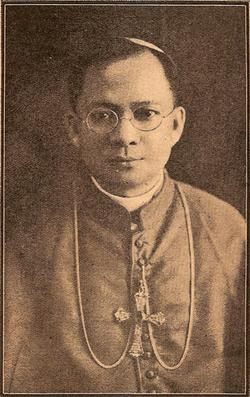Archbishop Gabriel Reyes was born on March 24, 1892 in Kalibo, Capiz, to Filipino parents. At the age of 13 he entered the Seminary of Jaro which was then directed by the Vincentian Fathers. Bishop Dennis Dougherty of Jaro, who later became Cardinal Archbishop of Philadelphia, U.S.A., ordained him on March 27, 1915 after which he was immediately appointed Coadjutor Parish Priest of the Cathedral becoming in a few months its Parish Priest.
As Parish Priest of Balasan (1915) he covered sixteen small islands many of which had neither roads nor chapels nor convents, but only ruins and on increasing number of Aglipayans and Protestants. These became the field of action of the energetic Gabriel until he became Parish Priest of Capiz, Capiz (1918). On July 20, 1920 Bishop James McClosky chose him to be the Diocesan Chancellor and Secretary and at the some lime Parish Priest of Sta. Barbara. In 1927 he became Vicar General of Jaro.
On October 11, 1932 Monsignor Gabriel Reyes was ordained Bishop of Cebu in the Cathedral of Jaro by the Apostolic Nuncio, Archbishop Guillermo Piani, S.D.B., with the assistance of Bishop James McClosky of Jaro and Bishop Alfredo Verzosa of Lipa. Two days later he was installed in Cebu. On April 28, 1934 Cebu after more than three centuries was elevated by Pius XI into an Archdiocese with Bishop Gabriel Reyes as the First Archbishop. As the Ecclesiastical Province of Santisimo Nombre de Jesus Cebu had for its suffragans in 1934 the following: the Dioceses of Jaro (1865), Calbayog (1910), Zamboanga (1910), Bacolod (1932 detached from Manila), and Cagayan de Oro (1933).
On the occasion of the Archdiocese’s Golden Jubilee in 1984, Archbishop Ricardo J. Vidal issued a Pastoral Letter in which he mentioned the achievements of Archbishop Reyes. Now follows a long quotation from the same Pastoral Letter:
With the able hands of Archbishop Gabriel Reyes, the Archdiocese began to embark on a series of noble projects designed to nurture the faith that had already been planted. In September of 1934, the weekly newspaper Lungsuranon appeared in its maiden issue. It was to help instruct the faithful on the fundamentals of the faith and to hold in check the advances of other sectarian propaganda. The Archbishop encouraged the establishment of “Catholic Action” in the Parishes of Cebu and Bohol as well as the Catechesis for children and the Association of the Propagation of the Faith. He ordered the holding of Diocesan Eucharistic Congresses in all the Parishes of the Archdiocese in preparation for the International Eucharistic Congress which was scheduled in Manila in February of 1937. In 1933 he established in Cebu the Adoracion Nocturna Filipina and in 1940 the Knights of Columbus. On July 27-29 of 1937 he convened the Third Diocesan Synod of Cebu wherein decrees adjusted to the new Code of Canon Law (1918) were adopted. Truly a pastor of souls, Archbishop Reyes himself handled spiritual exercises for the common laborers, with hundreds of them attending every year.
Giving concrete response to the evangelical imperative on the works of mercy, Archbishop Reyes laid the foundation stone in 1939 for a larger structure of the Asilo de la Milagrosa to take care of the orphans and the aged. He supported the Association of St. Vincent de Paul to help the poor and the needy. Furthermore, he erected the now defunct Holy Child Hospital with the same purpose in mind.
To mark the celebration of his Sacerdotal Silver Jubilee in 1940, Archbishop Reyes embellished the Cathedral erecting therein a marble altar which unfortunately did not survive the war. He encouraged religious vocation among the youth and ordained every year dozens of new candidates to the priesthood.
He established the Parishes of Guadalupe, Tabuelan, Simala and Santa Lucia to add to the existing parishes and, launching a more vigorous evangelization program, he started the “Catholic Hour” over radio station DZRC.
In 1945 the Treaty of Peace was signed. The Archbishop, pained almost to the point of nervous breakdown by the great destruction caused by the Second World War, such as the destruction of the Cathedral, his residence, the seminary, several churches, convents and colleges, resigned to the will of God, commenced the work of reconstruction. His labors did not pass unrecognized for on August 25, 1949 he was appointed by the Holy Father Pius XII as Coadjutor to Archbishop Michael O’Doherty of Manila with right of succession (and Apostolic Administrator sede plena). With the death of the Archbishop he took canonical possession of the archi-episcopal See of Manila with the distinction of being its first Filipino Archbishop (September 29, 1949).
Archbishop Gabriel Reyes has the distinction of being succeeded by two who have become Princes of the Church: Julio Cardinal Rosales who succeeded him in Cebu and Rufino Cardinal Santos who succeeded him in Manila.

